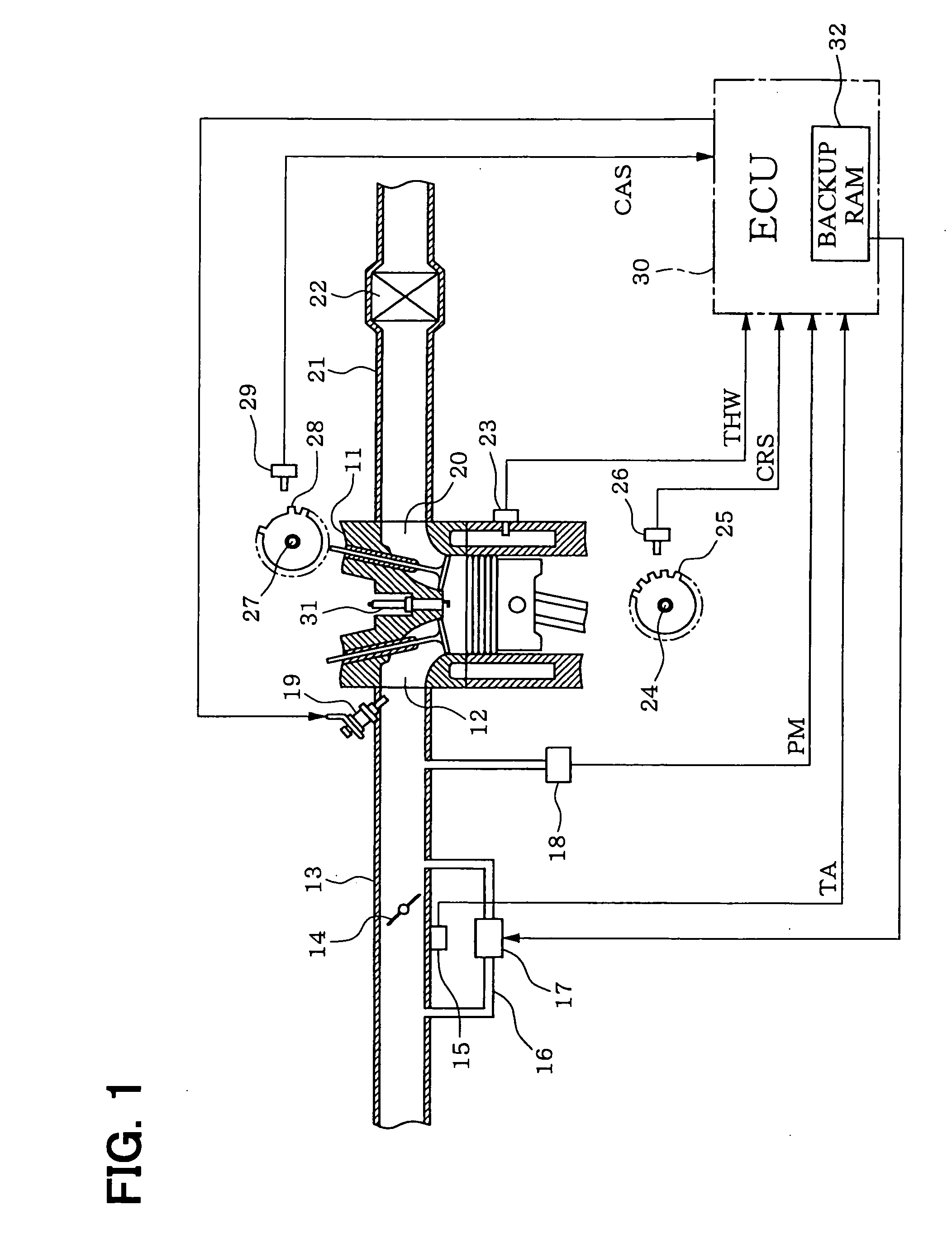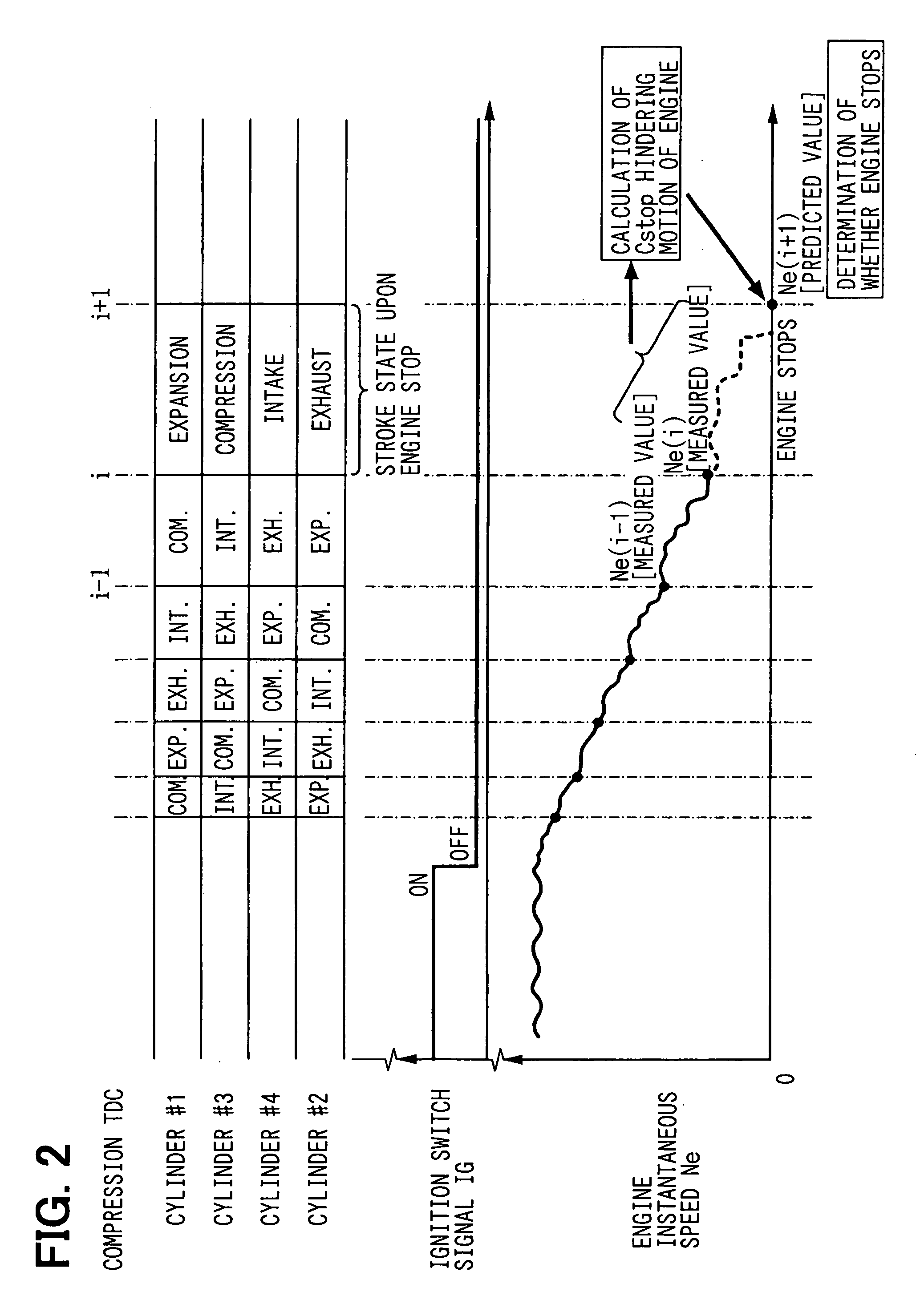[0008] The present invention is accomplished in view of the above-mentioned circumstances, and aims to provide an engine stopping and starting control device that can complete the starting in a short period without deteriorating the
exhaust emission.
[0010] In an intake port injection engine, for example, fuel is injected to the cylinder that is predicted by the prediction means during the intake
stroke immediately before the stop, whereby the engine is stopped with the air-fuel mixture sucked into and sealed in the cylinder. Further, in the direct fuel injection engine, fuel is injected to the cylinder, which is predicted by the prediction means during the intake stroke immediately before the stop or at the compression stroke, whereby the engine is stopped with the air-fuel mixture sealed in the cylinder. This defines a state wherein the air-fuel mixture is already sealed in the cylinder that is on the compression stroke of the next starting operation, thereby being capable of generating a first explosion by firing this cylinder on the compression stroke. According to this, the first explosion can be generated in a short period of within one stroke from the start of the cranking, so that the starting can be completed in a short period. Further, different from the injection asynchronous with the
starter, fuel is not injected to the cylinder that is not used for the starting operation
combustion. Thus, there is no chance to deteriorate the
exhaust emission during the starting operation.
[0014] As a
countermeasure, the engine stopping position is controlled to be the point before the passage of the predetermined
crank angle for securing the
combustion pressure for the first explosion at the next starting, i.e., to be the position where the
compression pressure of the air-fuel mixture in the cylinder on the compression stroke is low (the position where the rising amount of the
piston to the
top dead center can be secured at the next starting). This reduces the leakage of the air-fuel mixture in the cylinder on the compression stroke or reduction in the
compression pressure upon the engine stop. Further, the air-fuel mixture in the cylinder on the compression stroke can sufficiently be compressed for the next starting operation, thereby surely generating the first explosion having sufficient combustion pressure and, hence, one compression starting can surely be realized.
[0015] According to another aspect of the present invention, upon predicting which cylinder is on the compression stroke upon the stop, a
motion parameter representing the motion of the engine and a hindering parameter hindering the motion of the engine are calculated during the process for stopping the engine. A future parameter representing the future motion of the engine is predicted based on the above two parameters and the cylinder that is on the compression stroke upon the stop is predicted based on the predicted value of the future parameter. This can precisely predict the future parameter by considering a dispersion due to a manufacturing tolerance of the engine, secular change, and change in the engine friction (for example, difference in
viscosity due to
oil temperature change of the engine oil), during a process for calculating the
motion parameter and the hindering parameter, with the result that the cylinder that is on the compression stroke upon the engine stop can be precisely predicted from the future parameter.
[0017] Moreover, in another aspect of the present invention, upon controlling the engine stopping position, the intake air amount is increased when the cylinder that is predicted to be stopped on the compression stroke by the prediction means is in the intake stroke immediately before the engine stop, whereby the
compression pressure of the cylinder on the compression stroke upon the stop is increased to stop the revolution of the engine. When the compression pressure in the compression stroke is increased when the revolution of the engine is stopped as described above, the negative rotational torque generating in the compression stroke is increased to act as a force for hindering the revolution of the engine. This results in a
brake force that is applied on the revolution of the engine and the crank angle range in which the rotational torque becomes not more than the engine friction (the crank angle range in which the revolution of the engine can be stopped) is narrowed, and hence, the revolution of the engine is stopped within this crank angle range. This makes it possible to control the engine stopping position to be the point after the intake valve of the cylinder on the compression stroke upon the stop is closed and before the predetermined crank angle that can secure the combustion pressure for the first explosion. Moreover, the engine stopping position can be controlled by utilizing means for controlling the intake air amount (e.g.,
idle speed control valve,
electronic throttle valve, variable valve mechanism) so that the present invention can be applied to the existing engine
control system only by changing the control program.
[0018] The aspects of the invention explained above can be applied to the case where a driver operates an
ignition switch to stop and start the engine, but the present invention may be applied to an idle stop
system provided with automatic stop means for stopping the fuel injection and ignition to stop the revolution of the engine when a predetermined automatic stop condition is established during the idling, wherein the cylinder on the compression stroke upon the stop is predicted to inject the fuel to thereby seal the air-fuel mixture in the cylinder at the engine stop (idling) by the automatic stop means, and when the predetermined automatic start condition is established, the starting control is started to fire the cylinder on the compression stroke upon the stop, thereby generating the first explosion to restart the engine. This enables to realize one compression starting that cannot be realized by the conventional idle stop system, whereby the demand for shortening the starting time can be satisfied and the feeling of slowness at the restart is not recognized by a driver. Further, the
noise due to the driving sound of the starter can be reduced, thereby satisfying the demand for
silence.
 Login to View More
Login to View More  Login to View More
Login to View More 


